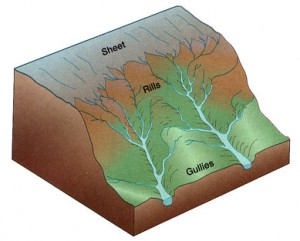Theory
Erosion and the Types of Erosion
Erosion occurs when the energy of water, wind or weight of soil is more than the cohesive forces binding the particles together, thus displacing soil particles as sediment. There are four major types of erosion including splash, sheet, rill and gully erosion. All four types of soil erosion can cause sediment displacement, transport and settling. All erosion control methods will either reduce the energy of the water/wind/soil weight that dislodges the soil, or increase the cohesiveness of the soil.

Source: http://releeconservation.com/erosion-control/
Sediment Transport and Particle Settling
Once a particle of sediment has been eroded from the landscape, the only practical way that it can be removed from runoff is through the process of particle settling. There are several ways into which the transported sediment particles can settle. These include: discrete particle settling, flocculent settling, hindered or zone settling and compression settling. Sediment is a major pollutant affecting waterbodies and is a main transport route of other waterborne contaminants. Sediments and nutrients are the primary contaminant of waterbodies in Oklahoma.
Fact Sheets
Raindrops And Bombs: The Erosion Process, Oklahoma State University
Soil Erosion, Arizona NEMO
Types of Soil Erosion, Arizona NEMO
Indicators of erosion, North River Catchment Management Authority, Australia
Videos
Sediment deposition and Stokes' Law, Tyson Ochsner, Oklahoma State University
Causes, Types and Damages of Errant Water

